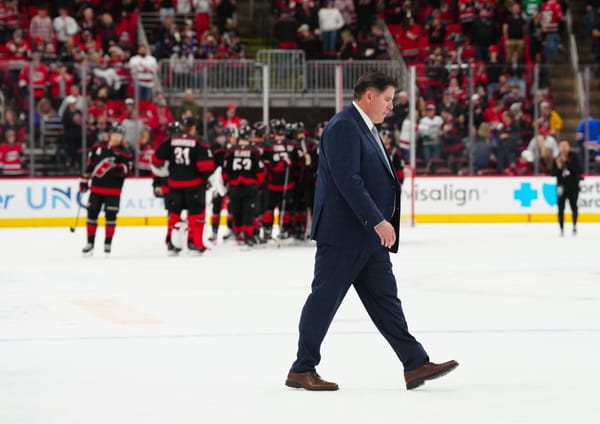2022 Report Card: Artemiy Panarin
The superstar winger posted a career-high point total in the regular season in spite of some concerning underlying play.
Expectations
Three seasons into his huge seven-year contract worth an average of about $11.6 million per year, Artemiy Panarin has already proven to be perhaps the best free-agent signing in New York Rangers history. In his first season with the club, the Bread Man scored a career-high 32 goals while adding a whopping 63 assists, for a total of 95 points (then also a career high) in just 69 games, thanks to the COVID-truncated 2019-20 campaign. He followed that up with 17 goals and 41 assists 42 games in 2020-21; this was yet another shortened season for the league as a whole, but also for Panarin personally as he had to deal with a wild situation stemming from Russia.
With his prolific scoring and dynamic playmaking ability, expectations for Panarin are always high, so — whether fair or not — when we evaluate his play, we do so with the knowledge of how high his ceiling is.
Performance
On the surface, Panarin had a stellar 2021-22 season. In 75 regular-season games, he surpassed his previous career high in points, tallying 96 on the strength of 22 goals and 74 assists. Panarin did a ton of damage on the power play, as he notched 37 of his 96 points with the man-advantage.
Despite the eye-popping point total, which ranked 11th in the entire NHL (his 74 assists ranked fourth overall), Panarin had some troubling underlying tendencies.
With Panarin on the ice at five-on-five, the Rangers were only around the league average in terms of expected goals for per 60 minutes:
Of course, as a whole, the Rangers struggled to generate consistent five-on-five offense all year, instead relying heavily on their lethal power play and an incredible goaltending season from Igor Shesterkin. Without Panarin on the ice at five-on-five, the Rangers’ xGF/60 was only 2.25 — 14 percent below league average. So while Panarin was not able to make the Rangers a major force offensively at five-on-five, he was able help to elevate them from their otherwise anemic ways.
The bigger issue with Panarin was on the defensive side. With him on the ice at five-on-five, the Rangers gave up numerous high-danger chances, which more than negated Panarin’s offensive impact:
Pretty ugly! By contrast, the Rangers were much more sound defensively without Panarin, with an xGA/60 of 2.54 (two percent below league average). Of course, their offense suffered, so they became a much lower-event team.
While Panarin is known for his offense and not counted on to be stellar defensively, his defensive impact was never this much of a negative in the prior two seasons with the Rangers. In 2020-21, the Rangers’ xGA/60 with Panarin on the ice at five-on-five was 2.46; in the season before, it was 2.57. Both were very close to the league average for each season.
In his debut Rangers season of 2019-20, Panarin also had a much greater positive impact on the team’s five-on-five offense. As part of that, he led the entire NHL in five-on-five points that season (59) while finishing third in Hart Trophy voting.
Panarin’s best impact in 2021-22, of course, came on the Rangers’ aforementioned power play, which was among the league’s most dangerous units.
Power plays are a major part of the game and thus should not be discounted. After all, the Rangers made it to within two games of the Stanley Cup Final this past season on the strength of their power play and Shesterkin’s goaltending. Panarin’s creativity with the man-advantage was a major factor in the team’s overall success. It was also fittingly on the power play that he scored the team’s biggest goal of the season: a Game 7 overtime winner against the Pittsburgh Penguins in the first round of the playoffs:
THE GOAL OF THE SEASON.
— New York Rangers (@NYRangers) May 16, 2022
NUMBER 10. ARTEMI. PANARIN. pic.twitter.com/q5wjGsKBZe
Panarin also picked up his play after a slow start to the season that featured several glaringly bad turnovers and waves of inconsistent play. He had four points in the opening seven games before finishing with 91 in his final 68 games. He might have had some ups and downs, but his elite scoring rate in spite of that highlights how much of a superstar he is.
Nevertheless, he slowed down again in the playoffs; the eye test did not look good, and he was below his normal scoring clip, putting up 16 points in 20 postseason contests — hardly anything to sneeze at, but still below his lofty standards. There was speculation among the fan base, and myself for that matter, that he was playing through an injury, particularly after he did not dress for the final two regular-season games after exiting early in the game before.
Whether an injury played a role or not, Panarin’s postseason play was underwhelming for a Rangers team that needed him to help drive more offense at even strength against the stingy Tampa Bay Lightning. He just did not look quite like himself in terms of decisiveness and dynamic playmaking. That, combined with his deteriorating defense across the whole season, spells some concerns for what the Rangers might get going forward out of soon-to-be 31-year-old.
Author Grade: B+
Banter Consensus: B+
A 96-point season would result in an A+ for most players in the NHL. But Panarin is not most players; he is a superstar, and as such, bears the burden of high expectations. The point total was excellent, as were his contributions to the power play. He also had a good impact on an otherwise paltry even-strength offense, and remains the most dynamic and exciting skater on the team. But a somewhat disappointing postseason (his Game 7 overtime winner notwithstanding) and some concerning defensive struggles keep Panarin just outside the A-range.
Advanced stats via Hockey Viz and Natural Stat Trick.





